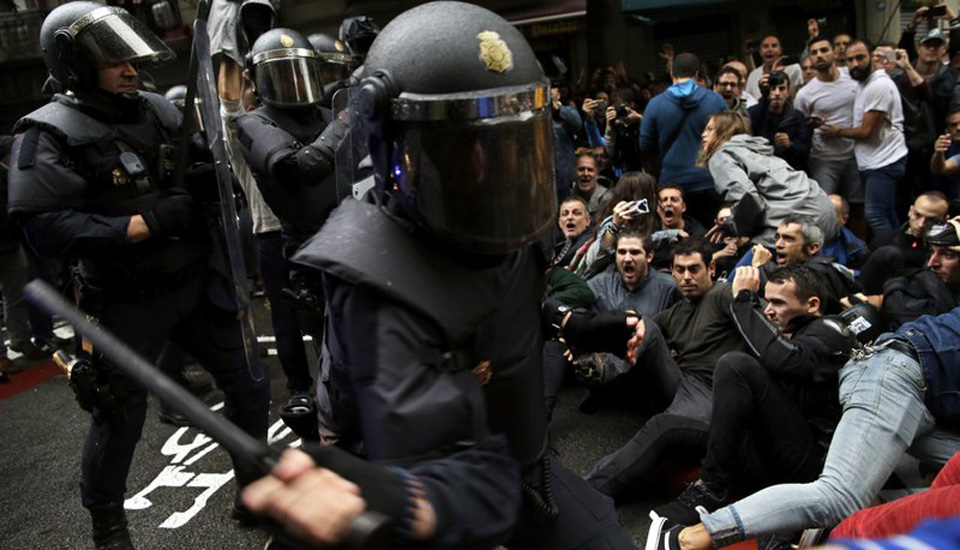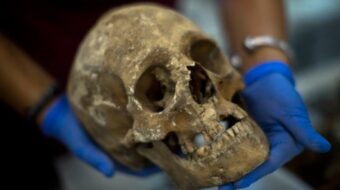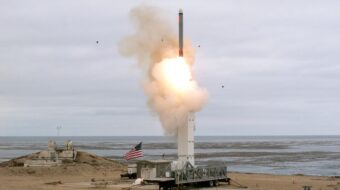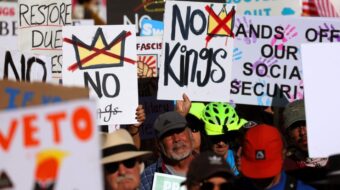
On Sunday, October 1, 10,000 Spanish national police, including the famous Guardia Civil (Civil Guard), intervened in an independence referendum organized by the autonomous regional government of Catalonia. Video evidence shows the police using excessive force in an attempt to block people from voting.
According to authorities of the Generalitat, which is the Catalan autonomous government headquartered in Barcelona, 844 people were injured. The Spanish national government claimed that numerous security officers were injured.
The battle over Catalonia’s relationship to the central government of Spain has been going on for centuries, and there have been plenty of violent clashes before.
From monarchy to fascism to democracy
Catalonia, in far Northeastern Spain was, during the early Middle Ages, an effectively independent state ruled by the Count of Barcelona. In 1137, a royal marriage brought it under the rule of the old Kingdom of Aragon. Aragon did not interfere with the distinctive Catalan language or strongly participatory local administration. But when King Ferdinand of Aragon married Queen Isabella of Castile (yes, them) in 1469, a centralizing process began.
Under the Habsburg dynasty, which ruled from 1516 to 1700, the friction between Barcelona and the central government was intensified, but it really took off after the War of the Spanish Succession, when an Austrian Habsburg and a French Bourbon prince vied for the Spanish throne. Most Catalans supported the Austrian, but the Frenchman, Phillip V, won out, and things went downhill from there, with sharp restrictions of Catalan liberties. Throughout the period of the Bourbon kings of Spain, roughly until 1931 with a couple of breaks, Catalans chafed under Madrid’s rule.
Yet the favorable position of Barcelona as an important port helped Catalonia to move ahead of the rest of Spain in terms of industrial development and the creation of a modern capitalist class system. In the late 19th and early 20th centuries, there was intensification of labor militancy and class struggle in Catalonia, with a flourishing of the anarchist and syndicalist movements. Governments under King Alfonso XIII tried to suppress this, but eventually, in 1931, the king fled and the Second Spanish Republic was declared in all of Spain, with strong support in Catalonia.
One achievement of the Republic was to grant Catalonia a very advanced level of local autonomy. For this reason, when the Spanish Civil War broke out in 1936, Catalonia found itself very much in the Republican camp. The head of the Catalan Generalitat at that time, Lluís Companys of the Catalan Republican Left party, played a major leadership role in the Civil War.
But army general Francisco Franco and his fascist and monarchist allies won, which resulted in the immediate revocation of Catalan autonomy, the abolition of the Generalitat, and efforts to completely suppress the use of the Catalan language. Thousands of Catalan activists and leaders were murdered by the Franco regime, including Companys.
When Franco died in 1975, his repressive state began to unravel. In 1978, a new monarchist constitution was approved which restored some of the democratic practices that had been won by Spanish republicans. The autonomy of Catalonia was restored, and the Catalan language was un-banned. Old political parties appeared, and new ones were organized all over Spain. Lluis Companys’ old leftist Esquerra reappeared, along with other Catalan parties of left and right that either supported or opposed independence.
The current Spanish prime minister is Mariano Rajoy, a rightist who got his start in politics within the old Franco establishment. Rajoy, who has headed the Spanish government since 2011, has promoted policies that have endangered the living standards of the working class and masses, threatened civil liberties with a “gag law” (Ley Mordaza), repealed two weeks ago, which severely penalized public protest, and the rights of organized labor.
Rajoy and many people around him are credibly accused of corruption. The corruption charges have even reached into the Spanish royal family.
Contested nationalism
The Catalan national movement, and now independence movement, includes both left- and right-wing political parties. The current president of the Generalitat is Carles Puigdemont, of the Junts pel Sí (United for “Yes”) party, generally considered a right-center Catalan nationalist group. He governs in coalition with a left-wing pro-independence party, the Canditatura d’Unitat Popular (Popular Unity Candidacy). In the last election to the Catalan Parliament, in 2015, this two-party coalition won 47.8 percent of the vote, and 72 of the 135 seats.
But not every party in Catalonia is pro-independence. The socialist and communist groups in Catalonia and Spain are against the monarchy and the Rajoy government, but they opt for a more advanced form of federalism rather than independence. There are also Catalan parties on the right that are militantly anti-independence.
So not everybody in Catalan politics thought the Generalitat’s idea of holding a referendum on independence at this point was a good one. This was true in the rest of Spain with parties which strongly repudiate the Rajoy government and agree with more autonomy for Catalonia in a federal republic (not monarchy).
But Puigdemont and his allies forged ahead. Spain’s constitutional court ruled the referendum illegal. Rajoy’s government swore to shut it down, threatening to arrest and prosecute hundreds of local Catalan officials if they helped to administer the poll. Ballot materials were confiscated by the central government.
Faced with such threats, many people in Catalonia who might not have originally supported a pro-independence vote now felt that the heavy-handed methods of the Madrid government constituted a challenge to basic democratic rights.
At a national level, most parties on the left, including the Communists and PODEMOS, called for Catalonia to be allowed to vote on the matter, on the grounds of the right of peoples to self-determination. For people on the right nationwide, this was now a clash of Spanish patriotism against Catalan subversion. That set the stage for Sunday’s confrontation.
Rajoy’s authoritarian response
In the end, 90 percent of those who voted opted for independence from Spain, with around a 43 percent turnout. One must, however, take into consideration that most people who opposed the referendum did not vote. On the other hand, in some cases, the vote was successfully blocked.
On Tuesday, there were massive demonstrations against the central government’s move in Barcelona and other Catalan cities. The Catalan police, called Mossos d’Esquadra, and firefighters were cheered because they were seen as having defended voters against the national police.
Puigdemont demanded that those who had ordered and carried out the repression be brought to justice, and that the damage they did to the buildings and furnishings where the voting was being carried out be paid for.
Puigdemont also announced that the Catalan parliament would meet and discuss the results of the vote, and whether this meant Catalonia will now declare full independence from Spain. Yet, he also insists that independence is about to be declared.
Meanwhile in Madrid, both Rajoy and King Felipe denounced the Catalan vote. Rajoy met with his coalition partners, the social democratic Socialist Workers’ Party of Spain (PSOE) and the right-populist Ciudadanos (Citizens’ Party). PSOE leader Pedro Sánchez chided the government for its heavy-handed tactics and called for negotiations, but Ciudadanos demanded suspension of Catalan autonomy. There were demonstrations of Spanish nationalists and fascists denouncing the Catalan vote.
The Communist Party of Spain (PCE) and its branch in Catalonia, PSUC-viu, denounced the repression as part of a tendency of Rajoy to crush democratic freedoms. In a joint statement signed by José Luis Centella, the General Secretary of the Communist Party, the two parties said “we understand that this is not the time for unilateral measures, nor to apply article 155 of the Constitution, nor for a declaration of independence” (article 155 would permit the abolition of Catalan autonomy). At the same time, Centella called for more demonstrations in support of democratic rights.
Now what? Puigdemont has said there should be political negotiations mediated by an outside entity, perhaps the European Union. But the leadership of the European Union has already declared itself completely against the Catalan referendum. Puigdemont has in his favor the fact that there is a lot of anger against Rajoy’s violent tactics, and also that Catalonia is Spain’s wealthiest and most prosperous region. Perhaps he thinks these two facts will force Rajoy to concede more autonomy, possibly in the form of Catalonia declaring itself a Republic with a federal relationship with the rest of Spain. This would be supported by much of the left in Spain. On the other hand, if Catalonia left Spain completely, it might have trouble negotiating separate membership in the European Union.
And the pro-independence forces in Catalonia might not be satisfied with anything less than full independence at this point.










